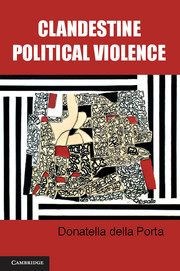Book contents
- Frontmatter
- Contents
- Acknowledgments
- Acronyms
- 1 Political Violence and Social Movements
- 2 Escalating Policing
- 3 Competitive Escalation
- 4 The Activation of Militant Networks
- 5 Organizational Compartmentalization
- 6 Action Militarization
- 7 Ideological Encapsulation
- 8 Militant Enclosure
- 9 Leaving Clandestinity?
- 10 Clandestine Political Violence
- Primary Sources
- Bibliographical References
- Index
10 - Clandestine Political Violence
Conclusions
Published online by Cambridge University Press: 05 April 2013
- Frontmatter
- Contents
- Acknowledgments
- Acronyms
- 1 Political Violence and Social Movements
- 2 Escalating Policing
- 3 Competitive Escalation
- 4 The Activation of Militant Networks
- 5 Organizational Compartmentalization
- 6 Action Militarization
- 7 Ideological Encapsulation
- 8 Militant Enclosure
- 9 Leaving Clandestinity?
- 10 Clandestine Political Violence
- Primary Sources
- Bibliographical References
- Index
Summary
Research on political violence, which has bloomed in recent years, has offered numerous explanations of the structural preconditions for, organizational characteristics of, and individual predispositions toward the development of clandestine political violence. In particular, literature on terrorism has linked it to a broad list of pathologies. Although rich in case studies, which are sometimes of good quality, terrorism studies as a field has been strongly criticized for the inadequacy of its sources of information, as well as its lack of theorization and predominant orientation toward counterterrorism. Social movement studies, which instead offers concepts and theories for the study of the evolution of repertories of protest, has only rarely addressed violence, especially in its more radical forms. This volume aimed at filling this gap by focusing on what I have defined as clandestine political violence. In this conclusion, I first synthesize my empirical results and then discuss some potential extensions of these results.
In considering clandestine political violence as an extreme form of violence perpetrated by political groups active in the underground, I have looked at the field of social movements for inspiration. Following that literature, I have considered the evolution of violence as embedded in social and political conflicts, influenced by the political opportunities available for elites and challengers as well as the material and cognitive resources available to contenders. Building on some important innovations in the area, I suggested that violence could not be satisfactorily explained by looking exclusively at structural conditions. Clandestine forms of violence, in particular, are embraced by tiny minorities that react with radicalization to conditions that lead others toward moderation.
- Type
- Chapter
- Information
- Clandestine Political Violence , pp. 282 - 294Publisher: Cambridge University PressPrint publication year: 2013



